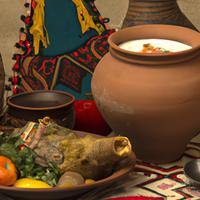
1 serving (150 grams) contains 250 calories, 10.0 grams of protein, 8.0 grams of fat, and 35.0 grams of carbohydrates.

Log this food in SnapCalorie

Nutrition Information
Calories |
394.3 | ||
|---|---|---|---|
% Daily Value* |
|||
| Total Fat | 12.6 g | 16% | |
| Saturated Fat | 4.7 g | 23% | |
| Polyunsaturated Fat | 0 g | ||
| Cholesterol | 47.3 mg | 15% | |
| Sodium | 630.9 mg | 27% | |
| Total Carbohydrates | 55.2 g | 20% | |
| Dietary Fiber | 1.6 g | 5% | |
| Sugars | 3.2 g | ||
| protein | 15.8 g | 31% | |
| Vitamin D | 0 mcg | 0% | |
| Calcium | 63.1 mg | 4% | |
| Iron | 3.2 mg | 17% | |
| Potassium | 236.6 mg | 5% | |
* Percent Daily Values are based on a 2,000 calorie diet. Your daily values may be higher or lower depending on your calorie needs.
Food Attributes
Source of Calories
About Hinkal
Hinkal is a traditional dumpling dish hailing from the Caucasus region, particularly popular in Georgian and Dagestani cuisine. It features a simple dough made from flour, water, and salt, often filled with spiced ground meat such as beef or lamb and occasionally accompanied by herbs. The dumplings are boiled and served hot, typically with a side of broth or sour cream. Hinkal is rich in protein due to its meat filling, making it a satisfying option for those needing energy. However, its refined flour-based dough adds carbohydrates and may be less suitable for low-carb diets. Additionally, the dish's high sodium content from seasoning and preparation can be a consideration for those monitoring their salt intake. Pairing Hinkal with fresh vegetables or a salad can help balance its nutritional profile, making it a hearty comfort food with room for adjustments to fit various dietary needs.



